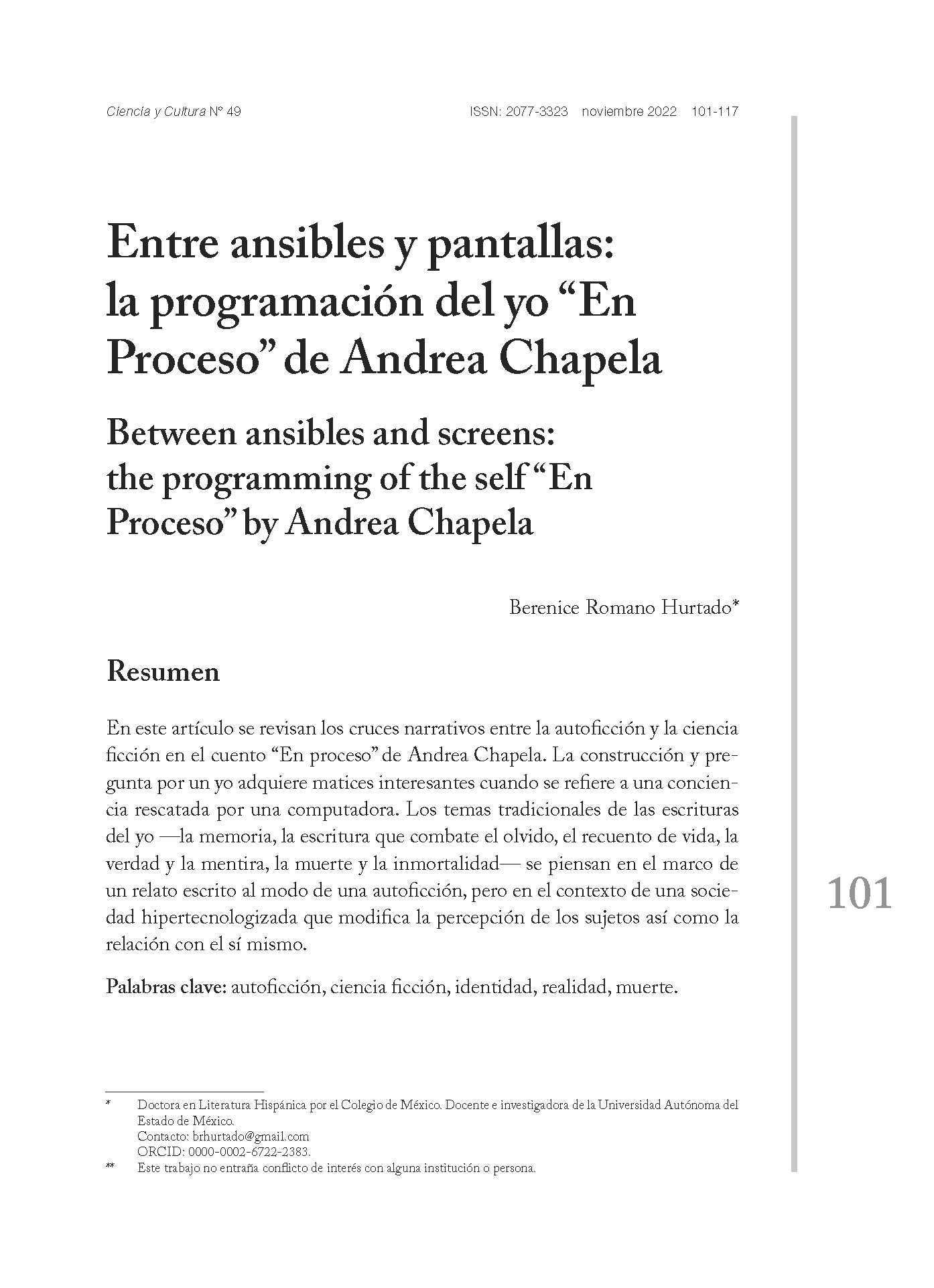Between ansibles and screens: the programming of the self “En Proceso” by Andrea Chapela
DOI:
https://doi.org/10.35319/rcyc.202249372Keywords:
autofiction, science fiction, identity, reality, deathAbstract
This article reviews the narrative intersections between autofiction and science fiction in the story “En proceso” by Andrea Chapela. The construction and question about a self acquires interesting nuances when it refers to a consciousness rescued by a computer. The traditional themes of the writings of the self -memory, writing that combats oblivion, the retelling of life, truth and lies, death and immortality- are thought of within the framework of a story written in the manner of an autofiction, but in the context of a hypertechnological society that modifies the perception of the subjects as well as the relationship with the self.
Downloads
References
Braidotti, Rosi. (2015): Lo Posthumano. Barcelona: Gedisa.
Chapela, Andrea (2020a). Ansibles, perfiladores y otras máquinas de ingenio. México: Almadía.
---------- (2020b). “La ciencia ficción es el mejor género para escribir sobre el presente” [entrevista realizada por Melissa Hernández Navarro]. Letras libres. 18 de diciembre.
Dällenbach, Lucien. (1991). El relato especular. Madrid: Visión.
Diaconu, Diana (2019). Caminos a la autoficción. Ensayo sobre el significado cultural de un nuevo género narrativo. México: Bonilla Artigas Editores.
López Pellisa, Teresa (2021). “¿Autoficción en la ciencia ficción? Autoficción especulativa en Diario de un viejo cabezota de Pablo Martín Sánchez” en La invasión de los alter egos. Estudios sobre la autoficción y lo fantástico. Nicolás Licata, Tahel Teicher y Kristine Vandenberghe (ed.). Veruert, Ediciones Iberoamericana, Madrid, 2021, pp. 35-63.
Llorens Serrano, Jaume (2016). La trascendencia del homo sapiens: el ícono posthumano en la ciencia ficción. Universitat Atònoma de Barcelona. Tesis doctoral.
Man, Paul de (1991). “La autobiografía como desfiguración”. Suplemento Anthropos, nº 29. Disponible en: https://ayciiunr.files.wordpress.com/2019/08/de-man-p-la-autobiografc3ada-como-desfiguracic3b3n.pdf
Montoya, Jesús y Campo, Ángel Esteban del (eds.) (2013). Imágenes de la tecnología y la globalización en las narrativas hispánicas. España: Iberoamericana/Vervuert.
Noguerol, Francisca (2013). “Barroco frío: simulacro, ciencias duras, realismo histérico y fractalidad en la última narrativa en español”. Montoya, Jesús y Ángel Esteban del Campo (eds.) (2013). Imágenes de la tecnología y la globalización en las narrativas hispánicas. España: Iberoamericana/Vervuert.
Poulain, Andrea (16 de abril de 2021). Ansibles, perfiladores y otras máquinas de ingenio, Andrea Chapela. Divagaciones de una Poulain. https://www.neapoulain.com
Pozuelos Yvancos, José María (2006). De la autobiografía. Teoría y estilos. Barcelona: Crítica.

Downloads
Published
How to Cite
Issue
Section
License
Copyright (c) 2022 Revista Ciencia y Cultura

This work is licensed under a Creative Commons Attribution-NonCommercial 4.0 International License.








